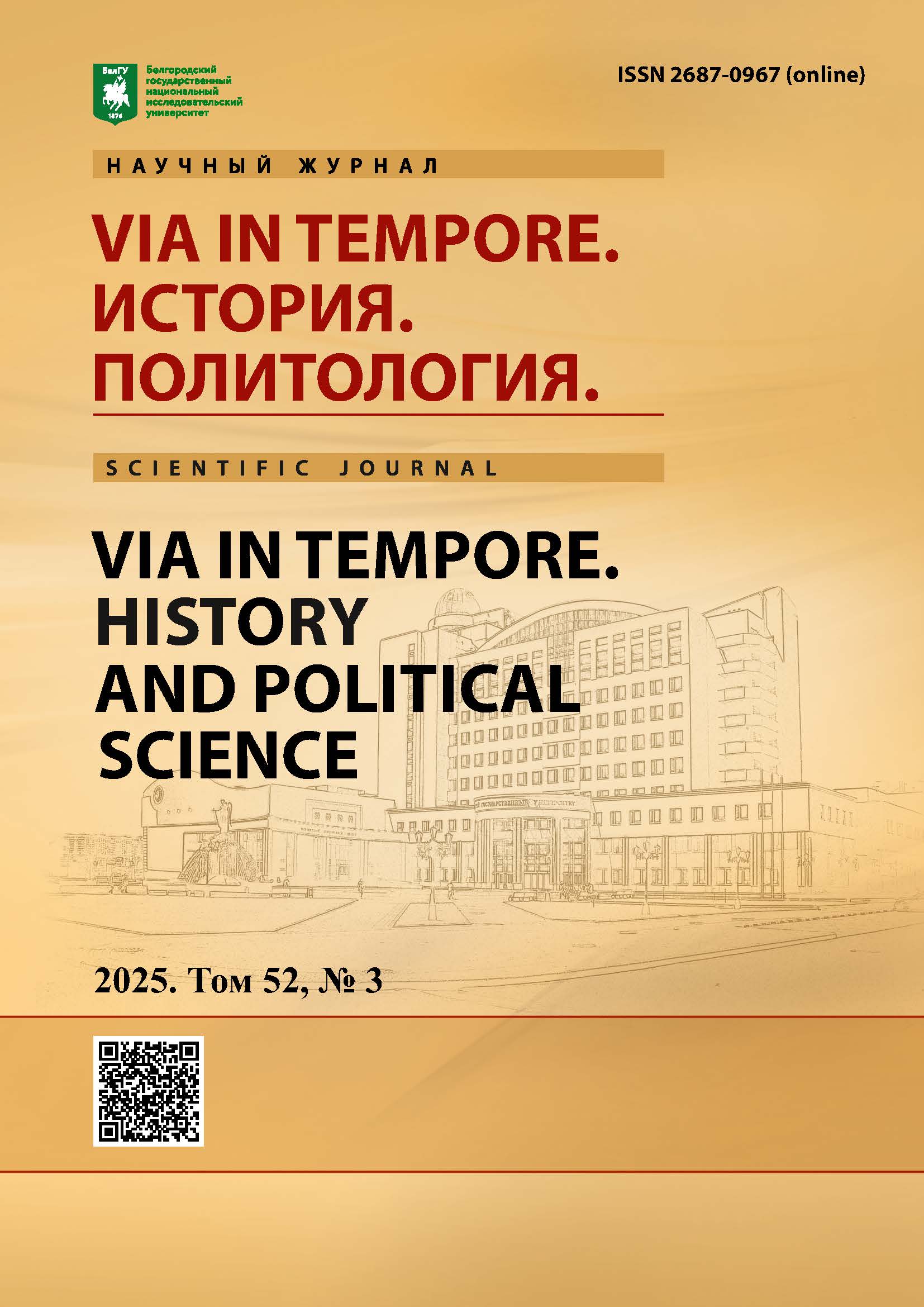To the Issue of Causes and Factors of Palestine’s Economic Development in the Early Byzantine Period: Problems of Reconstruction
DOI:
https://doi.org/10.52575/2687-0967-2025-52-3-578-591Keywords:
Byzantine Palestine, economy, climate change, trade networks, agricultural innovations, archaeology, interdisciplinary analysisAbstract
The article offers a view on the general model of economic development of the Palestinian region in the Byzantine era (4th to 7th centuries A.D.). A general reconstruction of the development model is carried out through a synthesis of climatic, archaeological, and socio-economic data based on an interdisciplinary approach. In the main part of the work, the author also analyzes competing historical concepts of the development of Byzantine Palestine (E. Huntington’s model, D. Bar’s theory, etc.), showing that the prosperity of the region was the result of a complex interaction between the climatic optimum, that took place in the late antique era, specificity of the state production infrastructure, specific demographic phenomena, and the economic shift that took place in the Mediterranean trade. Particular attention is paid to numerous climatic, as well as domestic and foreign policy «challenges», according to A. Toynbee, which caused the collapse of the established economic model in the 7th century. The author particularly emphasizes the complexity of the interaction between natural and anthropogenic factors in the development of the Byzantine economy at the regional level and draws attention to the successive rejection by historians and archaeologists of the monocausal model of the region's development in the early Byzantine period.
Downloads
References
Список литературы
Al-Shorman A., Shiyab A. The Effect of Function on the Selection of Raw Materials and Manufacturing Technology of Byzantine Pottery: A Case Study from Qasr Ar-Rabbah, South Jordan. In: Palestine Exploration Quarterly, 147(1): 4–19.
Avi-Yonah M. 1958. The Economics of Byzantine Palestine. In: Israel Exploration Journal, 8(1): 39–51.
Bar D. 2004 In: Population, Settlement and Economy in Late Roman and Byzantine Palestine (70–641 AD). In: Bulletin of the School of Oriental and African Studies, 67: 307–320.
Blanckenhorn M.L.P. 1912. Naturwissenschaftliche Studien am Toten Meer und im Jordental Bericht über eine im Jahre 1908. Berlin, Verlag von R. Friedländer & Sohn, 478.
Crown A.D. 1972. Toward a Reconstruction of the Climate of Palestine 8000 B.C. – 0 B.C. In: Journal of Near Eastern Studies, 31(4): 312–330.
Dan Y. 1982. The Foreign Trade of Palestine in the Byzantine Period. In: Cathedra: For the History of Eretz Israel and Its Yishuv, 23: 17–24.
Decker M. 2007. Frontier Settlement and Economy in the Byzantine East. In: Dumbarton Oaks Papers, 61: 217–267.
El-Khouri L. 2007. Roman and Byzantine Settlements in the Region of West Irbid. In: Palestine Exploration Quarterly, 139(3): 166–185.
Gichon M. 1974. Fine Byzantine Wares from the South of Israel. In: Palestine Exploration Quarterly, 106(2): 119–139.
Gregory J.W. 1930. Palestine and the Stability of Climate in Historic Times. In: The Geographical Journal, 76(6): 487–494.
Hirschfeld Y. 1997. Farms and Villages in Byzantine Palestine. In: Dumbarton Oaks Papers, 51: 33–71.
Hirschfeld Y. 2004. A Climatic Change in the Early Byzantine Period? Some Archaeological Evidence. In: Palestine Exploration Quarterly, 136(2): 133–149.
Huntington E. 1908. The Climate of Ancient Palestine. Part I. In: Bulletin of the American Geographical Society, 40(9): 513–522.
Huntington E. 1908. The Climate of Ancient Palestine. Part II. In: Bulletin of the American Geographical Society, 40(10): 577–586.
Huntington E. 1908. The Climate of Ancient Palestine. Part III (Conclusion). In: Bulletin of the American Geographical Society, 40(11): 641–652.
Kennedy H. 2008. Syria, Palestine and Mesopotamia. In: The Cambridge Ancient History. Late Antiquity: Empire and Successors, A.D. 425–600. Cambridge, Cambridge University Press: 588–611.
Kingsley S. 2001. The Economic Impact of the Palestinian Wine Trade in Late Antiquity. In: Economy and Exchange in the East Mediterranean during Late Antiquity. Proceedings of a conference at Somerville College, Oxford – 29th May, 1999. Oxford, Oxbow Books: 44–68.
Magen Y. 2008. Oil Production in the Land of Israel in the Early Islamic Period. In: Judea and Samaria: Researches and Discoveries [Judea and Samaria Publications (Series), 6]. Jerusalem, Israel Antiquities Authority: 257–343.
Magness J. 1993. Jerusalem Ceramic Chronology (circa 200–800 CE). Sheffield, Sheffield Academic Press, 277.
Patrich J. 1994. Map of Deir Mar Saba (109/7). Jerusalem, Department of Antiquities and Museums, 295.
Saidel B.A. 2005. Four Days at Khalasa: Using Aerial Photography and GIS Analysis to Reappraise Woolley and Lawrence’s Survey of Byzantine Elusa in the Western Negev Desert. In: Palestine Exploration Quarterly, 137: 53–64.
Salem H. 2011. Khirbet Siya: A Byzantine Settlement in Ramallah Region – Palestine. In: Liber Annuus, 61: 575–619.
Taxel I. 2013. The Olive Oil Economy of Byzantine and Early Islamic Palestine: Some Critical Notes. in: Liber Annuus, 63: 361–394.
Tubb J.N. 1986. The Pottery from a Byzantine Well near Tell Fara. In: Palestine Exploration Quarterly, 118(1): 51–65.
Abstract views: 10
Share
Published
How to Cite
Issue
Section
Copyright (c) 2025 Via in tempore. History and political science

This work is licensed under a Creative Commons Attribution 4.0 International License.


